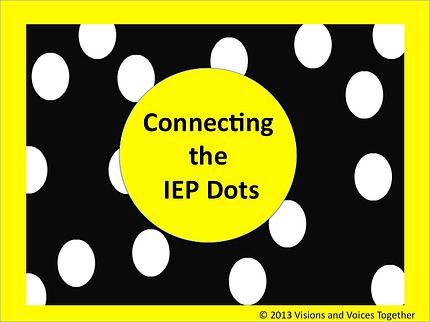Connecting the IEP Dots
Have you ever been at an IEP meeting and heard professionals rattle off evaluation results by telling the IEP team the student’s Standard Scores, Percentiles, Grade Equivalents, sharing a list of student’s “deficits”, and using disability labels to describe a student? Yet sadly, all too often there are few ideas given on how to tap into a student’s strengths to teach new skills, or help classroom teachers and parents understand the impact of the student’s learning styles and how differentiated instruction can be implemented in order to support the student, or how IEP goals can lead to the family’s vision of the future. Sometimes the dots don’t get connected at IEP meetings.
When the dots aren’t connected students lose out on being successful, teachers leave meetings bewildered as to what to do come Monday morning, and parents wonder what is actually going to change on a day by day basis so their child will be learning and feeling positive about themselves.
At IEP meetings we want meaningful information to be shared that will assist everyone in seeing the child/student as a whole person with gifts and how teachers and parents can connect the student’s gifts to ways to support the student to learn new skills. For example, if a student excels at karate, how can that help a teacher in the classroom? An obvious way might be to offer the student choices of books about karate to read. The teacher could also incorporate more active movement in lessons, allow the student to showcase her karate skills, incorporate karate into math word problems, or encourage the student to research the history of karate. Think of all the reading, math, and writing and higher level thinking skills that can be taught through an interest. Everyday in classrooms we need to witness more connections between interests and learning new skills.
We want insights, not just test scores to help the IEP team understand how the student’s learning differences manifest in school and how educators can differentiate instruction to meet the student’s needs. Educators need to be able to translate labels such as auditory processing difficulties, attention deficit disorder, or apraxia and connect it to what it specifically looks like for that individual student and then know how to best support the student in the classroom.
We need meaningful IEP goals that will make a difference in a student’s life – now and in the future. Have you ever read any IEP goals that made you wonder if your child/student would accomplish that goal, how in the world is that going to help them in everyday life? Here is an example of an IEP goal: to have the student rapidly name colors, numbers and words, and objects. Ooookay, and how is that skill of rapidly naming things going to help a student in the classroom, talking with his friends, or getting a job? Many times the dots don’t get connected between goals and how it will make a difference in the student’s life.
So, how can this pattern of disconnection at IEP meetings be changed? How can we connect the dots – connect strengths to learning new skills and concepts, insights from evaluations and observations to differentiated teaching, and connect IEP goals to what’s important in real life.
First, we need to stop being satisfied by just filling in the boxes on the IEP forms. Instead of just listing the student’s strengths on the form, spend time at the IEP meeting brainstorming how the knowledge of student’s strengths can assist the student to learn new skills.
Second, we can take a step back and ask ourselves what we know about how the student learns best. Discuss examples of the student’s learning styles when he is in the classroom and in other school environments (playground, PE/Music/Art classes, lunchroom, computer lab, etc.) and how teachers can differentiate the instruction to match the individual’s learning styles.
Third, when the IEP team is writing IEP goals ask how each goal is connected to the student’s and parents’ long term vision of a rich life. Do not settle for goals that are based on scoring higher on a test. Instead, expect IEP goals that are directly related to learning the grade level general education curricula, assisting a student in forming friendships at school, goals that will allow a student to use self-advocacy skills, or other goals that will result in positive outcomes and a more fulfilling life. The IEP team needs to be able to connect the dots between goals and visions for the future.
We have to be able to see and understand the relationship between students’ gifts and how teachers can engage them to participate in class and learn new content. We want the connection between students’ unique learning strengths and teaching strategies to be clearly defined so every student is a competent learner. The relationship between meaningful goals and quality of life are critical so parents can know their child’s school years are productive.
Connect the IEP dots at the next IEP meeting and ensure the student will reap the results of this new way of thinking.
